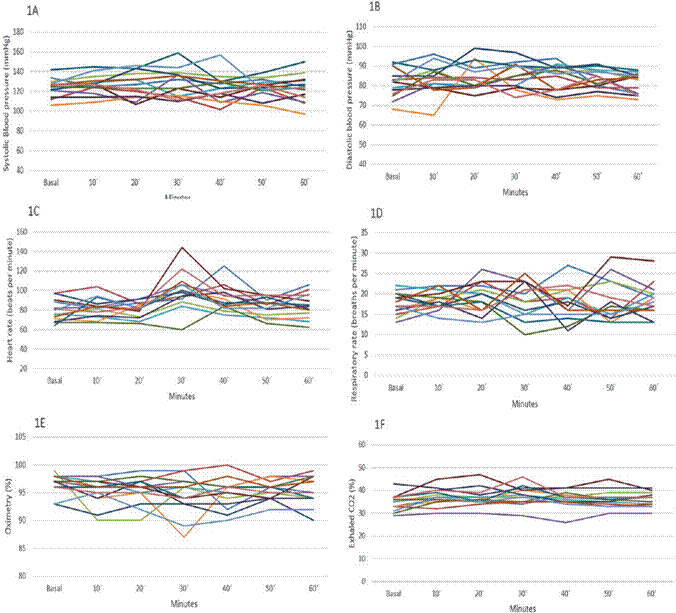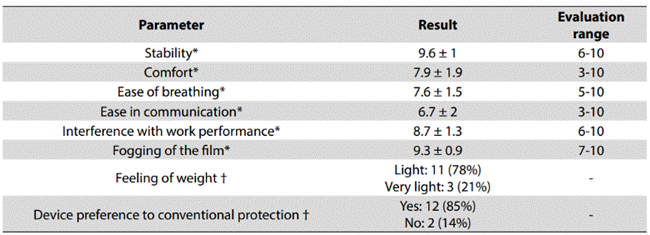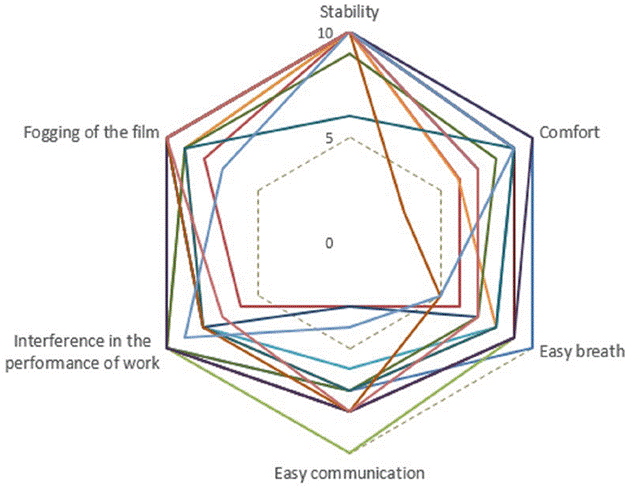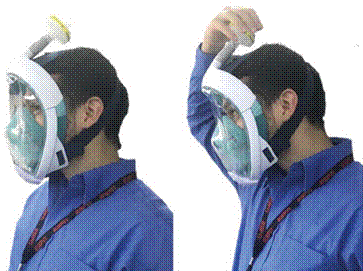Introduction
The SARS-CoV-2 pandemic has led to a deficit of personal protective equipment (PPE) for both health personnel and the community (1). This problem has been identified not only in 2020 but also in the 2003 pandemic with the SARS virus and in 2009 with the influenza A (H1N1) virus (2,3). This situation becomes a call to the scientific community to create and reinvent biosafety devices that can be used as PPE.
The use of modified snorkeling masks has been documented in different parts of the world to provide respiratory and facial contact protection to users exposed to aerosols of easily transmitted microorganisms such as SARS-CoV-2. Since the beginning of 2020, medical personnel from different countries have suggested this device as an alternative to high-efficiency disposable masks (4). At the same time, an Italian start-up carried out the initial approach to adapt the snorkeling mask for the administration of continuous positive pressure ventilation (CPAP) by 3D printing of the maskventilator circuit adapter of the ventilator (5).
Following this idea, teams from different countries, such as Belgium, Colombia and Croatia, began to disseminate the idea, bringing up the adaptation of the snorkeling mask for both CPAP and the replacement of disposable N95 masks and similar ones (6-8), under the argument of advantages in biosafety and comfort. A group of engineers and physicians from Prakash Laboratory (9) at Stanford University and the University of Utah have developed an adjustment of snorkeling masks seeking to characterize their properties as PPE in different mask brands. From this formal initiative, validations have been given by different groups, including our facility.
This potential PPE is being reported in US newspaper publications by doctors at Brigham and Women’s Hospital, Mass General, Lahey Clinics, New York-Presbyterian, and Tufts Medical Center, with additional input from Columbia, Harvard, MIT, Princeton, Rice, Tufts, University of California Berkeley, University of Texas Dallas and Yale (10). They point it out because the US Food and Drug Administration (FDA) takes months to approve a new medical device, and these prototypes are intended to be used only as a last resource. They follow recent FDA guidance that allows the use of experimental devices not approved by them and provides lines for warning labels:
To help foster the availability of equipment that might offer some benefit to health care providers and the general public during the COVID-19 outbreak, for the duration of the public health emergency FDA does not intend to object to the distribution and use of face masks, with or without a face shield (not including respirators), that is intended for a medical purpose (whether used by medical personnel or the general public), without compliance with the following regulatory requirements where the face mask does not create an undue risk in light of the public health (11).
Being the snorkeling mask an innovative PPE alternative that has been used in different countries, we aimed to identify possible adverse effects and determine the usability parameters of this device after 1 hour of testing in healthcare workers.
Methods
Observational, descriptive and longitudinal case series survey. The study was carried out after the ethical approval of the Health Research Ethics Committee of the School of Health Sciences of the Universidad Pontificia Bolivariana. The studied population was health personnel working at the Clínica Universitaria Bolivariana in May 2020, who met the eligibility criteria. The inclusion criteria were: people over 18 years of age who performed medical-surgical tasks, nursing or respiratory therapy, and who had used PPE. Exclusion criteria were comorbidities such as decompensated heart failure, non-compensated lung diseases (chronic obstructive pulmonary disease (COPD), uncontrolled or partially controlled asthma, diffuse interstitial lung disease), uncontrolled hypothyroidism, and personal history of anemia. The sample was non-probabilistic, expecting the participation of at least 10 health workers.
The elements used were the snorkeling mask, the adapter coupler valve, and the antimicrobial filter (Figure 1). The reference of the mask used was Easybreath Tribord / subea ® (Aquitaine, France), composed of the facial-screen shield, and the ventilatory port. The coupling valve was obtained by 3D printing (RepRap PRUSA i3 classic ® 3D Tarantula printer, Zhanjiang, China) using polylactic acid (PLA) as manufacturing material; the layer height is 0.2 mm, and the nozzle size is 0.4 mm. The antimicrobial filter (intersurgical ClearGuard 3® Mostoles, Spain) was for personal use.
Variables: sex, age, body mass index (BMI), heart rate, oxygen saturation, the exhaled fraction of CO2 (EtCO2), blood pressure, electrocardiography, usability parameters, and adverse effects. The latter includes the organoleptic properties that produce an alert in the individual due to their physiological reaction, such as headache, nausea, vomiting, visual disturbances, syncope/lipothymia, tinnitus, muscle weakness, fatigue, and dizziness. If the participant presented an adverse event, medical attention was provided in the facility emergency department. Data collection was performed during the 60-minute use test in an office supplied with equipment to simulate activities related to patient care and devices to monitor clinical parameters. The Nihon Kohden Vismo PVM 2701® monitor (Cambridge, MA, USA) was used for vital signs; CO2 was measured with the Microstream CapnostreamTM20 Oridion® capnograph (Minneapolis, MN, USA), which was calibrated and the same for all measurements of the participants.
Test development
Assistance personnel working at the clinic were invited to participate in the project. After the informed consent process, the evaluation and testing proceeded.
Baseline values (time 0) were taken when monitoring with a sphygmomanometer, 3-lead continuous electrocardiography, pulse oximeter, and capnography after verification of equipment operation. The snorkeling mask was then placed and fitted to the face, and the negative pressure fit test was performed, manually occluding the antimicrobial filter and inhaling (Figure 1).
Subsequently, the evaluation started with the simulation of daily service activities while taking the measurements every 10 minutes for 1 hour, and checking if the participants were feeling any adverse effects. At minute 30, they were asked to perform cardiopulmonary compression maneuvers (on simulation equipment) so they had a physical stress test for 10 minutes. The other activities consisted of orotracheal intubation, the passage of nasoand orogastric tubes, pronation of the patient, aspiration of secretions, taking anthropometric measures, among other activities, according to each professional profile.
After 60 minutes, the snorkeling mask was removed, and the perception of usability was assessed through a survey with the following parameters: mask stability, comfort, feeling of resistance to breathing, the weight of the mask, communication interference, interference in work performance, and fogging of the film. All aspects were rated from 1 to 10, where 1 is the worst and 10 is the best or most beneficial.
All the variables were collected in a survey designed in Microsoft Forms®, then the information was exported to Microsoft Excel®. After verifying the quality of the data, the statistical analysis was performed with the IBM SPSS version 24® program (Armonk, NY, USA). The qualitative variables are expressed in proportions, and the quantitative variables are expressed as mean and standard deviation or median and interquartile range (IQR), according to the normality tests. The graphics were made in Microsoft Excel®.
Results
Fourteen volunteer health workers were included. The median age was 34 years (30-42). 57% (n = 8) were men, 50% were overweight (median of BMI: 25.7; IQR: 23-28) and 21% (n = 3) had controlled hypothyroidism according to their latest medical records. The professions of the volunteers were: chief nurse (n = 7; 50%), medical specialist (n = 3; 21%), respiratory therapist (n = 2; 14%), and nursing assistant (n = 2; 14%).
A slight upward trend in blood pressure, heart rate, and respiratory rate between 20 and 40 minutes was registered (Table 1), the time when the volunteers performed physical stress exercises. None of the values occurred concomitantly to warning signals that required to stop the evaluation. Eight (n = 8; 57.1%) participants presented mild fatigue, especially after the resuscitation activity or when they spoke or had a conversation with the researchers. There were no abnormalities in electrocardiographic monitoring during the test, neither it was necessary to take arterial gases or activate the adverse effects attention protocol. The usability results were optimal, all dimensions evaluated had good perceptions by each participant (Figure 2) and the snorkeling mask had 85% of preference over conventional protection as N-95.

Figure 2: Trends of the variables during the test time with the snorkel mask. Panel 1A: systolic blood pressure 1B: diastolic blood pressure 1C: heart rate 1D: respiratory rate 1E: oximetry 1D: exhaled CO2. Source: self-creation
Table 1: Usability parameters

*Mean ±SD † n (%). Stability (1: unstable - 10: very stable); Comfort (1: very uncomfortable - 10: very comfortable); Ease of breathing (1: very difficult - 10: very easy); Interference with work performance (1: high interference - 10: low interference); Fogging of the film (1: high fogging - 10: low fogging). Source: self-creation

Figure 3: Evaluation of the usability parameters by participants. Each axis corresponds to one of the evaluated parameters. The dotted polygons represent the range of scores (0-5 and 6-10) and the solid lines connect the scores given by each participant. Each color represents a participant. Source: selfcreation.
Discussion
The adapted snorkeling mask has been welcomed in different countries, seeking an alternative for PPE in case of a shortage of biosafety material in services such as emergencies, intensive care units, general hospitalization, and even digestive endoscopy services (11,12). Taking into account the experiences found on the Internet, our social and economic context, along with the limitations of a pandemic, it was found that there were no relevant changes in the user’s clinical parameters and that the acceptance of this PPE alternative in health personnel was very good.
There are several interesting aspects in the assessment of this device as PPE, which must be analyzed in relation to its components. On the Internet and in the bibliographic search, the evaluation of the adapter for the snorkeling mask, adjustment, filtering, flow resistance, leaks, and CO2 tests were found in animated subjects (ergometry type) and inanimate ones, so this sporty equipment can safely replace a medical device in times when access and availability of PPE are limited (9).
An adapter is required to attach the filter to the masks and 3D printing technology facilitates its design and production. A laboratory in Barcelona (Spain) prints 3D adapters/coupling valves for the use of the snorkeling mask as PPE in the Hospital Clínico Universitario de Valladolid and the Hospital Universitario Infanta Leonor, which have had positive results, and the printed part fits snugly with no apparent leaks (13). However, the air outlet port of the masks varies depending on its reference and manufacturing house, so the adapter must be designed (14,15).
Thus, a good 3D design, according to the unique features of the mask, avoids the inwards leakage attributed to this adapter. To verify the coupling between the filter-adapter-mask, a seal test was carried out with manual obstruction of the filter to inspiration and expiration of the mask and filter, which was successful in our examination, and no leaks were observed at the coaptation sites of the parts. If present, a physician in London proposes to seal the adapter using 3M® microfiber elastic foam medical tape, which allows for multidirectional stretching, easily adapts and fixes in places with irregular contours even when repeatedly washed (15), which may be an emergency option in case of evidence of leaks.
Another challenge faced with a new PPE device is the protection capacity against pathogenic microorganisms, for which the filtering system of the device must be considered. The filters used in this study are used in ventilation equipment and anesthesia machines to protect the patient from microorganisms and particulate matter such as latex. In Colombia, there are several types of filters available, such as mechanical, electrostatic, HEPA and CPAP; endorsed by the Government regulatory agency (Instituto Nacional de Vigilancia de Medicamentos y Alimentos INVIMA) (16).
The filters can be mechanical or electrostatic. The former uses a compact fiber matrix that is folded to increase the surface area, and it has very small pores that physically prevent the passage of microorganisms and particles. The latter use a similar material polarized in an electromagnetic field; both are effective for preventing contamination of the system (17). According to the manufacturer information, the mechanical respiratory filter used (Clear-Guard ™ 3 with monitoring port, Intersurgical, Mostoles, Spain) is more than 99.99% effective at filtering the bacteriophage φ174 virus (0.027 μm) (18), so SARS-CoV-2 will be equally filtered since its size ranges from 0.07 µm to 0.16µm (17,19), as well as other pathogens such as human immunodeficiency virus (HIV) (0.8 µm); hepatitis C virus (HCV) (0.06 µm); Mycobacterium tuberculosis (0.3 µm); Pseudomonas aeruginosa (0.5 µm); and Staphylococcus aureus (1 µm) (19).
Similarly, the tightness of the mask to the user’s face is important for protection. Studies with N95-type face masks have determined that facial anatomy is a variable related to leaks inside the mask. In the snorkeling context, these masks are designed for underwater use, where their tests show tightness, as long as it is configured or has an adequate molding to the user’s facial anatomy, with an important component of external pressure exerted by water (a factor that is clearly absent in this case). This plays an important role in leakage inside a snorkeling mask, and we evidenced it indirectly in our participants after the non-homogeneous adjustment of the mask in some of them. It is necessary to use masks with a predetermined size to achieve a better fit according to craniofacial features. Bearing this in mind, it is important to recognize that the“total inward leakage” includes the combination of particle penetration through filter media, particle leakage through the face seal, and any component of the interface (18).
Another assessment is the ability of the particles to enter through the one-way exhalation valve located in an area comparable to the user’s chin. Prakash Lab addressed this aspect. The National Institute for Occupational Safety and Health (NIOSH) standard “exhalation valve leak test” (Section 84.182) states the pressure and flow rates required for a performance standard equivalent to typical N95 respirators. Prakash Lab concluded that the leakage flow from the exhalation valve (reference Decathlon FreeBreath) is less than the maximum flow allowed to comply with the NIOSH regulation (30 mL/min for 25 mmH2O pressure) (9).
On the other hand, most of the clinical parameters in our study were within the normal physiological values, including the CO2 flow exhaled by the user, which did not accumulate inside the snorkel mask nor generated symptoms in the participants that evidenced the effect of CO2 on the central nervous system such as nausea, dizziness, fainting, or altered state of consciousness; this finding is similar to other evaluations.
A recent report in the United Kingdom concerning the use of an equally adapted snorkeling mask determined, in one person, that EtCO2 levels during 20 minutes of testing did not have significant changes in its values (EtCO2: 3.7-4.0 kPa or 27-30 mmHg) (20). Prakash Lab performed a test under standard monitoring (ECG, SatO2, PA, EtCO2, and inspired CO2) for 80 minutes on a volunteer. They found an increase in inspired CO2, consistent with rebreathing and insufficient clearance of exhaled CO2. However, EtCO2 values were stable, as well as vital signs. Similarly, they carried out exercise tests with volunteers running on a treadmill under continuous monitoring for 60 minutes. The results showed that the change in the inspiratory CO2 during the use of the device in an exercise that simulates that of most health care work was insignificant and it was in line with NIOSH standards (9).
Regarding the usability parameters, the Colombian technical standard NTC 3851 of the ICONTEC (Instituto Colombiano de Normas Técnicas y Certificación) determines that «the acceptance of the worker towards the respiratory protection equipment must be considered in the equipment selection process (…) The factors to take into account are comfort, resistance to breathing, weight, interference to communication, and interference in work performance» (21).
In the usability evaluation we included these factors, and we found a good acceptance and that most of the volunteers preferred it to conventional PPE. The parameter with the lowest score was “communication interference”; all the participants reported that they had to increase the volume of their voice to transmit a message or an order to the evaluator, being this a failure of the device since communication in any of the medical-surgical services must be effective and assertive. To fix this problem, a developer hospital group of the device in Paris improved the intercommunication between the health team by creating an additional 3D adapter at the bottom where the one-way exhalation valve is originally located (22). Similarly, Prakash Lab proposed a Bluetooth-mediated system for transmitting voice and allowing conversation among staff (9). Both alternatives can be adjusted to the initial design to allow easy and smooth communication.
The low frequency of the screen fogging was one of the characteristics with the greatest acceptance of the device. However, we observed that some participants in whom it fogged up did not achieve an adequate facial seal during the test. We attributed this to air leakage into the mask, which was annoying, but without greatly affecting the simulated activities. Fogging may be a useful feature to verify the seal of the mask on the face prior to risk exposure. Greig et al. reported a small degree of fogging of the internal surfaces that does not affect vision (20). Two surgeons who performed a tracheostomy on a COVID-19 patient in an intensive care unit did so with an additional modification to the initially proposed one with an adapted flashlight on top to provide light for the procedure and improve visibility (22).
The adapted snorkel mask is a feasible alternative in environments where there is a shortage of PPE as long as the tightness on the face is verified, the protective filter is used and it is decontaminated after use. We even consider it as a replacement opportunity for conventional PPE (N95 respirator, glasses, and visor), which is characterized by the easy fogging of the glasses, a greater number of pressure zones (due to the number of elements used for protection), and the constant feeling of fatigue. As perspectives, and given its use in the context of the COVID-19 pandemic, the frequency of cases of SARS-CoV-2 infection in health personnel using conventional PPE and those using this alternative can be monitored. Furthermore, the use of this system in patients suffering from COVID-19 disease can be also be considered, as recently published (23).
Conclusions
The adapted snorkeling mask as PPE is a functional alternative in the context of scarce resources and a pandemic with high transmission such as COVID-19, since it has few clinical effects and high acceptability among health professionals. This snorkeling model needs further usability and effectiveness evaluations.















